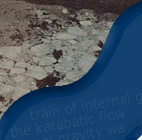

 |
||||||
The Labrador Sea Experiment and air-sea interaction |
 |
During 1995-1998 I worked at the University of Toronto, Canada with Prof. Kent Moore. We were heavily involved in the Labrador Sea Deep Convection Experiment. The experiment was aimed at observing deep ocean convection, an important component in the earth's climate system, through a mixture of meteorological and oceanographic observations, theory, laboratory studies and numerical modelling. Further details can be found in the BAMS overview paper LabSea Group (1998) and in the data documentation paper by Krahman et al. (2003). We were lucky enough to do some instrumented aircraft field work during the experiment - here are some photos from our boundary-layer flight and some other pictures and information in Toronto . Further details of the aircraft-based field work and our support of the ship cruises is described in our BAMS article (Renfrew et al. 1999). The front cover of which is pretty cool. My Labrador Sea work has resulted in a series of papers on air-sea interaction during cold, atmospherically unstable conditions. |
|
A detailed analysis of a cold-air outbreak on 8 February 1997 is described in Renfrew and Moore (1999). Here we mapped out the structure of the boundary-layer roll vortices we observed, and estimated the changes in air-sea heat fluxes with distance from the Labrador Coast. We noted a roll signature in humidity, but not in temperature, a feature we hypothesised was due to the very cold atmospheric temperatures. We observed massive heat fluxes (~600 W/m2) at the sea ice edge, but which declined with fetch. The case has been simulated by the MM5 mesoscale model in Pagowski and Moore (2002). In addition, idealised cloud-resolving modelling experiments have been able to reproduce many of the characteristics of the roll vortices and examined the role of the sea-ice zone in influencing the surface heat fluxes both over the sea-ice zone and downstream - see Liu, Moore, Tsuboki and Renfrew (2004, 2006). We also compared observations from the 1997 R/V Knorr cruise with meteorological analyses from the ECMWF and reanalyses from NCEP (Renfrew, Moore, Guest and Bumke, 2002). In the case of the NCEP reanalysis the heat fluxes were vastly overestimated during periods of strong winds and large air-sea temperature differences. The cause of this was a poor roughness length formulation (Renfrew et al. 2002, Zeng et al. 1999). This has been changed in the operation NCEP model, but not for the reanalysis - you have been warned! In Moore and Renfrew (2003) we examined how this poor parameterisation affects air-sea heat fluxes in the western boundary currents. The work described above has continued with a focus on the Irminger Sea, as well as the Labrador Sea, as part of the Greenland Flow Distortion Experiment. Please see the GFDex website for details and links to a wide variety of observational and numerical modelling studies. |
 |